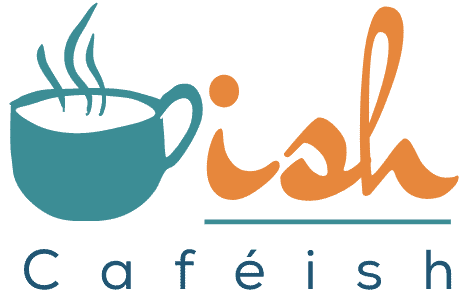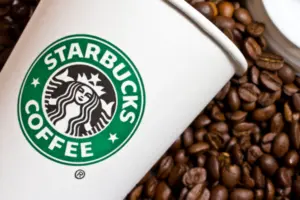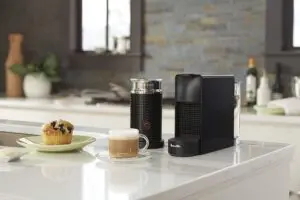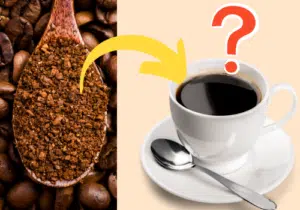Iced Latte vs Cold Brew: What’s The Difference? 3-Minute Read
Disclosure: This post contains affiliate links and I may earn a small commission (at no extra cost to you) if you click through and make a purchase. Thanks in advance – I really appreciate it!
There are so many coffee drinks out there. We know it’s easy to get confused. So if you’re looking to become a pro at ordering at a cafe and are trying to figure out the difference between an iced latte and cold brew, this article will answer your questions.
Both are cold, both come with ice—but what is the difference between an iced latte and a cold brew?
Key Takeaways:
Iced Latte vs Cold Brew
- An Iced latte is made by adding 1-2 shots of espresso to chilled milk and topping it with ice. Cold brew on the other hand is made by steeping coarse ground coffee in room temperature water for an extended period of time (12-24 hours) and then filtering out the grounds and serving it over ice.
- The cold brew has a smooth, flavorful, and mellow taste of coffee.
- A typical iced latte tastes like sweet creamy milk with a hint of coffee flavor.
- Cold brew has more caffeine than a typical iced latte.
- Cold brew keeps very well in the fridge and will taste great for up to 2 weeks.
So, although both iced latte and cold brew are cold coffee beverages, they differ immensely when it comes to the brewing method, ingredients, caffeine content, acidity, flavor & taste.
If you were looking for the differences between these two cold coffees then you’ve landed on the right page.
Read on to find out more!
To make an iced latte at home, you’ll need to make espresso first.
Iced Latte & Cold Brew; What’s the difference?
Iced latte is made with espresso and cold brew is made by steeping coffee grounds in water. But the differences don’t just end there. Here’s a brief rundown of the major differences between an iced latte and cold brew. In the rest of this article, I will explain each of these differences in much more detail.
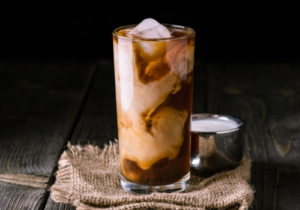
Iced Latte
- Ingredients: Espresso, chilled milk & ice.
- Brew time: Minutes
- Taste: Sweet, creamy taste with mild coffee flavor.
- Caffeine: 68mg caffeine/espresso shot
- Calories: Moderate amount of calories because of the added milk.
- Strength: Mild, mellow flavor.
- Shelf life: 1 day.

Cold Brew
- Ingredients: Coffee grounds, water, time.
- Brew time: 12-24 hours
- Taste: Smooth, sweet taste of coffee.
- Caffeine: 200mg caffeine/16 fl. oz.
- Calories: Low-calorie beverage
- Strength: Bold strong coffee flavor.
- Shelf life: Up to 2 weeks.
What is an Iced Latte?
An iced latte is a simple and straightforward cold espresso-based drink. There is no standard recipe to make an iced latte but typically it’s made with 1/4 part espresso and 3/4 part chilled frothed milk and it’s topped with ice.
The drink can be made with either one or two shots of espresso, so the quantity of the milk also varies accordingly.
It’s extremely common during summer or whenever the warm weather hits, and it’s really a treat of its own.
Iced latte is made using a large quantity of milk, as a result, it tastes mostly like sweet milk and the coffee can barely be felt.
It’s a perfect choice for those who like coffee but can’t handle the strong flavor and acidity of an espresso.
An iced latte is a perfect combination of bitter coffee balanced by delicate sweetness and creamy, frothed milk.
Where did the Iced Latte come from?
The iced latte dates back to the early days of coffee before there were any espresso machines or even electricity.
Coffee houses in Europe started serving iced caffeinated beverages during colder months to keep customers inside where it was warm.
So basically iced lattes have been on coffee shops’ menus practically since commercial coffee shops became a thing.
What is Cold Brew coffee?
Cold brew is simply coffee that has been brewed with cold or room temperature water rather than hot water and usually involves a long steeping process—anywhere between 12-24 hours. In terms of flavor, cold brew is generally characterized as smooth, low-acid, and heavier than its hot brewed counterparts.
The lack of heat prevents many of the solubles in the coffee from completely dissolving resulting in a coffee with much lower acidity, enhanced smoothness, greater sweetness, and generally little to no bitter component.
The longer brewing time and higher coffee to water ratio are necessary to give the water more time to extract those solubles from the coffee grounds.
So if you find that the acidity of hot coffee bothers your stomach, switching to a cold brew may help significantly.
Cold brew is most commonly made as a coffee concentrate. One major benefit of a concentrate is that you can more easily store the cold brew in the fridge for at least two weeks.
With a concentrate, you pour it into a cup and then add water or milk, typically at a ratio of 1:2 (coffee concentrate to water).
Where did the Cold Brew coffee come from?
Although cold brew has been around for centuries, it’s really in the last ten years that it’s become a staple on coffee shop’s menus and recognizable by most coffee drinkers.
The cold brew method became popular when it was discovered that brewing at room temperature for a long time would result in an agreeable taste with less acidity than something brewed hot.
Cold brew is a great drink for folks who’ve never brewed coffee at home because precision isn’t as important as with other brewing methods.
You don’t need a scale or a kettle or anything. All you need is a brewing vessel, coffee grounds, water, and time.

Iced Latte & Cold Brew: Difference in Taste
The cold brew has a smooth, flavorful, and mellow taste of coffee. Cold brew uses time instead of heat to extract the coffee’s oils, sugars, and caffeine, this is why cold brew is generally less acidic and less bitter than regular drip coffee.
A typical iced latte is made with a shot of espresso, ice, and a large quantity of milk. As a result, iced latte tastes like sweet creamy milk with a hint of coffee flavor.
Cold milk has a tendency to impart creaminess and natural sweetness to any drink that it is added to.
Since iced latte is mostly chilled milk with a little amount of espresso, it tastes like sweet cold milk with a mild coffee flavor.
Iced Latte vs Cod Brew: Caffeine
Generally speaking, cold brew has more caffeine than a typical iced latte.This is because the ratio of coffee to water is so much greater, with iced latte being more diluted with cold milk.
All the caffeine in an iced latte comes from espresso.
So if a standard 16oz. iced latte is made with one shot of espresso that means it will have 68mg of caffeine (1 shot of espresso has 68mg of caffeine).
On the other hand, a 16oz. cold brew typically has 200mg of caffeine.
The cold brew begins as a concentrate and this concentrate is very high in caffeine, possibly three times higher than espresso.
However, as a concentrate, cold-brew coffee is also typically cut with water or creamer, which levels things out a bit.
Still, even some cold brews that are brewed and sold as ready-to-drink beverages contain higher levels of caffeine than your standard iced latte.
The difference in Brewing Methods
If you are okay with prepping your coffee one day before you plan to drink it, then cold brew is a great option to quench your coffee cravings on a hot day.
You don’t even need a lot of ingredients or a machine to make a refreshing cup of cold brew.
All you need is freshly ground coffee, room temperature or cool water, a large container like a mason jar or French press, and a sieve or something to filter out the grounds.
On the other hand, to make a delicious cup of iced latte you’ll need to brew espresso first.
Which lasts longer, cold brew or iced latte?
Cold brew keeps very well in the fridge and will taste great for up to 2 weeks. Plus, if you make it as a concentrate, it’s a great space-saver in the fridge.
Iced latte will generally taste the best within the same day it was brewed, but you can save it for a day in the fridge.
After the first day, you may find that it starts tasting a bit sour.
Which is Better For You: Iced Latte or Cold Brew?
Neither cold brew coffee nor iced latte is better than the other. Every person has different tastes and may prefer one drink to the other.
Iced latte suits someone who is looking for a light, milky refreshing drink with a mild coffee flavor that they can easily add sugar or sweetener to.
Cold brew coffee better suits someone who is looking for a smooth and sweet coffee that is a little more caffeinated and wants to add a small amount of cream or milk.
Traditional iced latte will always dilute further as the ice melts, while cold brew will still retain a strong coffee flavor after. My suggestion is to try both and see what you like best.
Which is Healthier: Iced Latte or Cold Brew?
It comes down to what you put in your iced latte or cold brew, like the type of sweeteners or if you put whipped cream on top.
The sweeteners like coffee syrups added to an iced latte will add much more sugar than consuming it as a plain latte over ice. And if you add whipped cream to a latte, it will add more fat than if it was just the espresso and milk. So as much as we love experimenting with sugars and other creams, we just enjoy it in moderation.
How To Make Iced Latte
Iced lattes are a popular drink in the summer and can be made at home with whatever milk you like. All you need to make them is a single shot of espresso, some ice cubes, and cold milk.
Instructions
- Brew espresso and if you’re going to add sweetener, mix it in while the espresso is hot, so it dissolves completely.
- Let the espresso cool for a few minutes then pour it into a glass filled with ice.
- Pour your milk in the glass with ice and espresso and give it a good shake or stir.
Here’s a video that can help you make your own iced latte at home!
How To Make Cold Brew
To make a cold brew, all you have to do is grind coffee coarsely, add water, let it sit, and strain.
Instructions
- Find an appropriate vessel for brewing your coffee, anything from a french press to an iced tea pitcher will work just fine!
- Grind your coffee beans on the coarsest setting. You will need a 1:8 ratio of coffee to water.
- Pour your coffee grounds directly into the bottom of your preferred brewing pot.
- Pour the pre-measured, room temperature, or colder water over the grounds.
- Cover and steep in the refrigerator for 12-24 hours, keeping in mind that the longer you let it brew the stronger the coffee will be.
- After a preferred steep time, use a coffee filter o filter out the coffee grounds.
That’s it, your cold brew is ready to be enjoyed!
Check out this video to understand how you can brew a refreshing cup of cold brew.
Conclusion
If you’re looking for a refreshing morning drink, then both the cold brew and the iced latte are going to be great options. There’s not a “best” option here – it all comes down to personal preference.
If you like your coffee strong and at the forefront when you’re drinking, you’ll want to go with a cold brew.
If you’re a fan of flavorings and don’t necessarily need that much espresso in your face, you might go for an iced latte instead.

Amit Gupta
Hi, my name is Amit Gupta, and I am the owner and contributor at Cafeish. My obsession with coffee started when I received my first French press as a gift almost ten years ago. Since then, my love of coffee – and the number of coffee gadgets I own – has grown considerably.
Most Popular
ABOUT US
We are a team of coffee affcianados with experience and expertise in making world renowned coffee. In fact, preparing the best coffee ever with a fluffy top reminds us of magic, with secrets of how to achieve each particular effect. Making coffee is not our only hobby, we always keep our ears open as to what’s happening around and what scientists and manufacturers produce for consumers. It’s not an easy task to do – it’s rather time consuming. Hence, Caféish website was launched.
LEGAL DISCLAIMER
Caféish is a participant in the Amazon Services LLC Associates Program, an affiliate advertising program designed to provide a means for sites to earn advertising fees by advertising and linking to Amazon.com. Caféish also participates in affiliate programs with Clickbank and other sites. Caféish is compensated for referring traffic and business to these companies.
